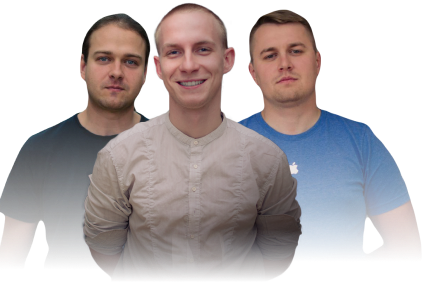The niche of construction services has gone through a ton of economic challenges, global workforce shortage, and an increase in accidents over recent years. The Internet of Things (IoT) comes in as a game-changer solution to help businesses take on those and other challenges through automation, performance boost, and safer investment opportunities.
Implementation of interconnected smart construction software solutions can give your business a sharp competitive edge. Namely, by streamlining project control and security via enhanced visibility of all construction sites and operations in real time. More importantly, the IoT is trusted by many, and some expert forecasts back this trust with impressive figures.
The total value of the market driving the IoT in the construction industry is expected to hit $26,79 billion by 2028. Over 70% of construction providers worldwide are considering the implementation of this and other advanced tech as a prerequisite for future growth.
Ready to take on these prospects by storm? Here’s what Requestum specialists can share from firsthand experience and expertise to guide you the right way.
Applications of IoT For Construction
Construction companies increasingly focus on technologies that provide the most effective solutions to basic problems. IoT-based systems do this better than others. They keep everything under control, from remote monitoring of workers' actions and reporting to sensitive management of stocks and equipment.
Such systems can even help you monitor and control the temperature of hardware and materials, track their location, and automate processes. And there’s more where this comes from.
Full workflow transparency
In construction, IoT helps to track construction progress, prevent emergencies, improve work processes, and manage the presence and performance of employees. It all comes down to a great opportunity to cut unforeseen expenses and gain more control over workflow deadlines.
Bluetooth tags, RFID tags and barcodes, GPS sensors, wearable devices, and cameras with a 360° view enable the ultimate monitoring across all construction resources and environmental conditions in real time.
Discover the best practices and tips for building a successful construction app
This degree of coverage allows you to efficiently set up the supply chain, optimally use and save materials, and avoid non-compliance with tech and hazard regulations. And the benefits of intricately tracking employees' working hours, manner of work, and quality of materials they use are obvious.
For instance, wireless temperature sensors can help you track and regulate the durability of concrete. The system constantly monitors its status and sends text alerts in case of significant changes. At the same time, continuous data collection improves analytics, which brings its own results.
Total control
Applications of the IoT in construction enable real-time smartphone updates on how many people are at the facility, where they are situated, and what the staff is busy with at the moment.
Smart P2P-based systems connect directly to the cloud and transmit alarm signals to portable devices. They can even distinguish the movements of animals and can immediately warn of any suspicious activity.
All this gives the management the real picture of things so that it can promptly respond to emerging issues. For example, the ID cards or smartwatches equipped for each worker on the site show:
- statistics by type of work per hour, day, or month;
- the total number of people on each site;
- movement around the facility;
- accounting of working hours
Drones and IP cameras are also becoming an essential part of the smart project management system. The drones can be used for photo and video capture when building large areas (residential areas, roads, parks), creating panoramas, and 3D models.
For one-time shootings, drone operators are usually involved. For more global and permanent projects, droneports are installed - autonomous kiosks with spare batteries for drones for continuous monitoring of the construction site.
IP cameras monitor all construction stages inside the facility. They help register info on whether workers properly take a shift, whether the equipment is in order in certain parts of the site, how actively construction is being carried out, etc.
The cameras determine the presence or absence of helmets, vests, and other protective gear, generate daily reports, and send lists of violators. This way, the provider can control on-site safety and avoid negligence-related accidents.
IoT technologies significantly cut the overall cost of construction projects and prevent the emergence of new items of expenditure due to equipment downtime, lack of materials, or human errors. They solve the issues of discipline and control of personnel on construction sites.
ID cards and smartwatches mark the exit of an employee outside the perimeter of the facility, staying in non-working areas longer than the set time (in the smoking room or neighboring area), the beginning and end of the shift, lack of registration in the system, the number of employees at the facility at the moment, the number of daily registered people on the object, and more.
Based on all that data, one can draw up analytics on construction dynamics and calculate hourly employee wages.
Case Study: Home Services Management

Security and performance
IoT devices can also help monitor workers’ health. Wearable devices enable the tracking of heart rate and blood pressure. They can monitor brainwaves to register worker fatigue and prevent collapse or other industrial accidents.
The most common pains in this niche are improper organization of work and violation of the work schedule. Smartwatches and identification cards recognize an employee by biometric data, transmit information about their exact location, and immediately notify the manager in case of an emergency.
The accelerometer detects a person's position relative to the ground and identifies sudden acceleration (a sure sign of a fall) or other sudden and atypical movements.
Lastly, the IoT technology can be used to create a digital map of the site. This grants a timely update on the on-site risks and notifies all employees about them. GPS-guided machines provide the operator with a 3D view of the job site. This eliminates errors and allows operators to navigate the terrain with confidence, as well as control people, objects, structures, and surrounding equipment.
For instance, a device attached to a construction crane records a task's length and sends reports to the manager's computer. This helps simplify processes and eliminate inefficiencies.
Just-in-Time inventory management
Marking materials with RFID tags allows you to obtain data on their quantity and location instantly. This makes it possible to request the delivery of new batches to the site in time.
The role of IoT for scheduling in construction also can’t be understated since it cuts downtime dramatically. Automated JIT provisioning eliminates the need to order additional consumables that cannot be used immediately. This way, you can cut even more costs.
Cost-saving
The cost of a construction project depends largely on its duration and overall fuel consumption. With effective management of gas stations, timely maintenance, and the ability to modernize equipment, it can be drastically reduced.
With GPS trackers with IoT-enabled sensors, you can accurately track the location of your fleet of vehicles. This will help you track performance data and move to predictive maintenance.
IoT-enabled sensors that monitor vibration or temperature help determine the best time to service equipment. This extends the life of the equipment and increases its resale value.
Prospects of IoT in Construction
While we may only stand at the very beginning of the industrial IoT, it already comes in more than handy on a construction site. Routine tasks are overwhelmingly automated. We are witnessing how artificial intelligence and machine learning will connect with it while other technologies become available at no great cost.
Let’s create custom software that works for your business
Augmented reality (AR)
AR can be used to plan, automate measurements, provide on-site project information, improve teamwork, and provide safety education.
Creating interactive AR models allows you to attract customers at an early stage. Everybody has already seen tons of project presentations, discussions, and studies. A fresh take on project demonstrations motivates people to turn to your company. Meanwhile, you get to identify inconsistencies and inaccuracies in the structure and make appropriate changes to prevent possible issues.
Building Information Modeling (BIM) and digital animation
Smart input-based modeling allows you to create a digital structure of the objects being built. This helps to better understand the physical and functional nuances of the construction process to detect and fix problems and inconsistencies early on.
You can use digital animation to improve visualization, modeling, analysis, simulation, and project planning. This may include automated progress tracking, security, resource planning, quality assessment, and hardware optimization.
Conclusion
IoT-powered tools are sure to develop further, so digital skills will become more in demand in the niche of construction. The sector is still highly under-digitized, and many companies fail to fully grasp the potential of new technologies. However, they are becoming aware of their necessity.
The IoT has the potential to transform an industry that is still in the research phase for implementing this technology. Many construction sites today generate large amounts of valuable information that goes unaccounted for. That should change soon.
You may need to restructure your business to keep up. Some of the old staff will have to be cut, but new employees who can overcome the challenges of using advanced devices and analytics will need to be found.
A single information space is needed to effectively use the IoT in the construction industry. One of the main tasks is to combine smart devices into a digital software package capable of working on demand.
At Requestum, we have both the tools and skills to wield them to help you improve the existing and introduce new advanced IoT solutions. Contact us if you are looking to boost the overall efficiency and security of your construction routine while gaining a sturdy competitive edge.

Our team is dedicated to delivering high-quality services and achieving results that exceed clients' expectations. Let’s discuss how we can help your business succeed.


SHARE: